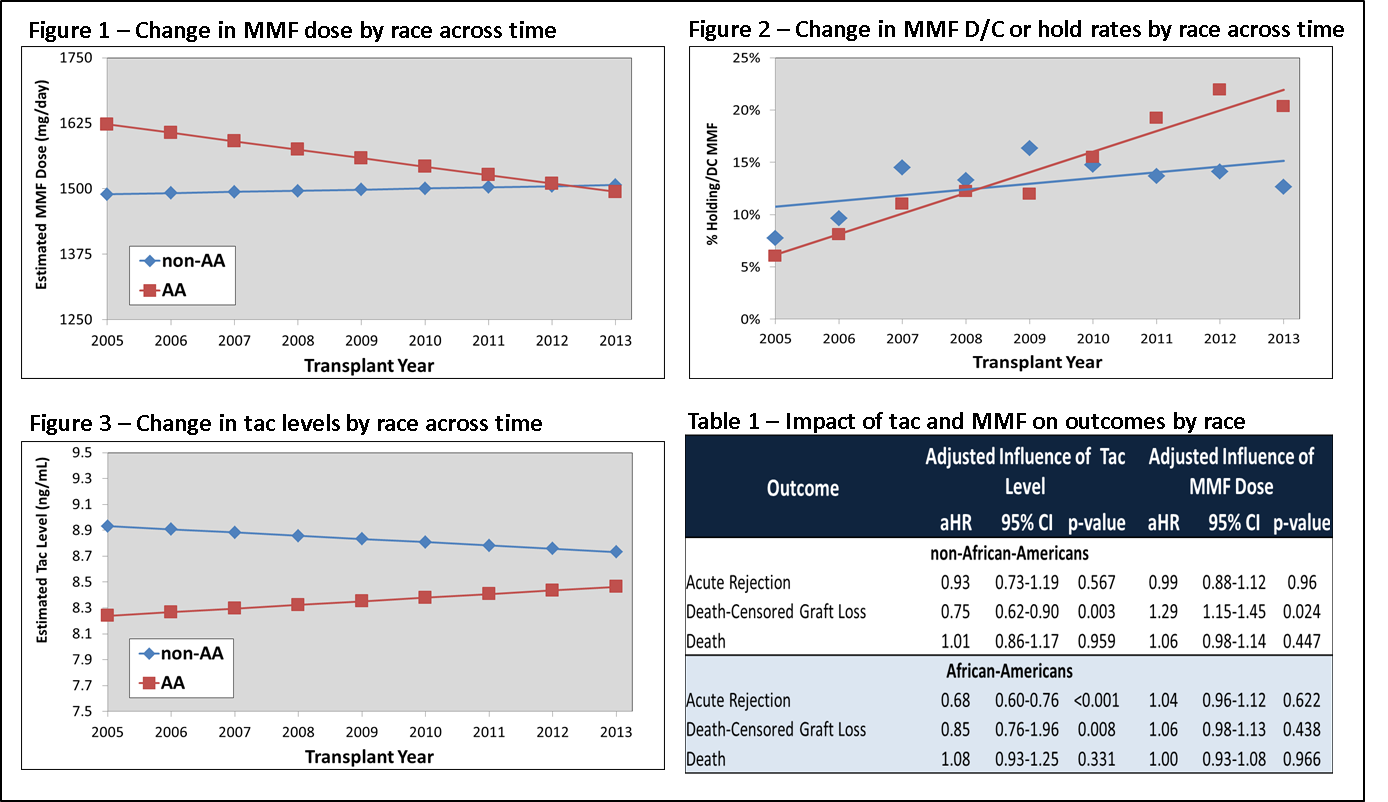Change in Mycophenolate and Tacrolimus Exposure by Transplant Vintage and Race.
Transplant, MUSC, Charleston, SC
Meeting: 2017 American Transplant Congress
Abstract number: C164
Keywords: African-American, Calcineurin, Mycophenolate mofetil
Session Information
Session Name: Poster Session C: Kidney Complications III
Session Type: Poster Session
Date: Monday, May 1, 2017
Session Time: 6:00pm-7:00pm
 Presentation Time: 6:00pm-7:00pm
Presentation Time: 6:00pm-7:00pm
Location: Hall D1
There is strong evidence that both tacrolimus (FK) and mycophenolate (MMF) have improved outcomes in kidney transplantation; yet, the impact of exposure of these immunosuppressants on outcomes and racial disparities is not well studied.
Methods: Eight-year longitudinal cohort study of kidney transplant (KTX) recipients. Intra-patient tacrolimus and mycophenolate l were assessed and compared by transplant vintage (txp yr), stratified by race (non-AA vs. AA). Pediatrics, non-FK/MMF regimens and non-renal transplants were excluded. Standard univariate and multivariable regression were used to analyze data.
Results: Between 2005-13, 1,217 KTX recipients with MMF/FK exposure data were included (follow-up through 2015). More than half (53.7%) were African Americans (AA). The mean MMF dose was 1672±463 mg/day during the first 3 years post-transplant. Transplant vintage did not appreciably impact MMF dosing in non-AAs (0.7 mg/day/year, p=0.903), while MMF dosing significantly decreased in AAs by txp yr (-20.5 mg/day/year, p<0.001, Figure 1). AAs also had a significant increase in the rate of MMF being held or discontinued by txp yr, which did not change in non-AAs (Figure 2). Mean FK levels were lower in AAs vs. non-AAs in 2005. However, over time, there was a slight decrease in non-AAs (-0.03 ng/mL/year, p=0.279) and a slight increase in AAs (+0.03 ng/mL/year, p=0.247), such that mean FK levels were similar by 2013 (Figure 3). In terms of outcomes, higher FK levels were protective against rejection in AAs only, but were protective against death-censored graft loss in both AAs and non-AAs. MMF dosing had no appreciable impact on outcomes in AAs, but higher MMF dosing was a significant risk factor for death-censored graft loss in non-AAs (Table 1).
Conclusion: FK and MMF exposure have significantly changed over time and differed by race. In non-AAs, those transplanted more recently tended to have lower FK exposure with similar MMF exposure. In AAs, MMF exposure has decreased in recent years, while FK exposure has slightly increased. The impact of FK and MMF exposure on outcomes also differ by race and likely reflect the providers' improved understanding of immunosuppressant tolerability by recipient race.
CITATION INFORMATION: Soliman K, Posadas Salas A, Taber D. Change in Mycophenolate and Tacrolimus Exposure by Transplant Vintage and Race. Am J Transplant. 2017;17 (suppl 3).
To cite this abstract in AMA style:
Soliman K, Salas APosadas, Taber D. Change in Mycophenolate and Tacrolimus Exposure by Transplant Vintage and Race. [abstract]. Am J Transplant. 2017; 17 (suppl 3). https://atcmeetingabstracts.com/abstract/change-in-mycophenolate-and-tacrolimus-exposure-by-transplant-vintage-and-race/. Accessed December 28, 2025.« Back to 2017 American Transplant Congress
